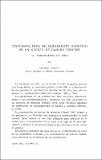Por favor, use este identificador para citar o enlazar a este item:
http://hdl.handle.net/10261/162169COMPARTIR / EXPORTAR:
 SHARE
BASE SHARE
BASE
|
|
| Visualizar otros formatos: MARC | Dublin Core | RDF | ORE | MODS | METS | DIDL | DATACITE | |

| Título: | Cincuenta años de aislamiento genético de un núcleo de ganado porcino. III. Parámetros de cría |
Autor: | Solano Uriarte, Alfonso | Palabras clave: | Ganado porcino Poblaciones cerradas Parámetros de cría |
Fecha de publicación: | 1984 | Editor: | Consejo Superior de Investigaciones Científicas (España) | Citación: | Genética ibérica 36: 77-94 (1984) | Resumen: | [EN] A closed herd of swine, started in 1931 with four males and four females, has been reared for 50 years and 20 generations. After three different periods of selection the present mean inbreeding is about 35%. The means of litter survival index, piglet viability at 21 days, and piglet viability at 56 days are 96, 84, and 82 % respectively, for the last period. None of these parameters have shown a dec1ine along the life span of the herd. For the three periods of development the mean numbers of alive piglets per litter were 10.4, 10.1 and 9.8 at birth, 8.3, 8.8, and 8.6 at 21 days, and 7.9, 8.4 and 8.4 at weaning (56 days); the mean weights of piglets were 4.5, 4.5, and 4.8 Kg at 21 days and 11.7, 11.6 and 14.2 Kg at 56 days. The inbreeding of mothers affects mainly to litter characteristics at birth and to first lactation period, while the inbreeding of litters affects piglet development. The means per litter of the Lush-Mollin productivity index are 40.2, 41.7 and 42.8, for the three periods. There are positive correlation between the mean productivity index of litters of a female and the productivity index of its first (r = 0.57**) and second litters (r = 0.43**). [ES] Un núcleo cerrado de ganado porcino, fundado en 1931 con cuatro verracos y cuatro cerdas, se ha desarrollado a través de tres períodos selectivos diferentes hasta alcanzar, al cabo de 50 años y 20 generaciones, unos niveles de consanguinidad medios del orden del 35 por 100. El índice de supervivencia de las camadas y la viabilidad de los lechones hasta los 21 y 56 días de edad tienen unos valores medios de 96, 84 y 82 por 100, respectivamente, en el último período, no habiendo sufrido deterioro durante e1 desarrollo del núcleo. En los tres sucesivos períodos de desarrollo el número medio de lechones vivos por camada es de 10,4. 10,1 y 9,8 al nacimiento, 8.3, 8.8 y 8.6 a los 21 días de edad y 7.9, 8.4 y 8.4 al destete a los 56 días; los pesos medios de los lechones son de 4.5, 4.5 y 4.8 Kg a los 21 días y 11.7, 11.6 y 14.2 Kg a los 56 días. La consanguinidad de las madres afecta principalmente a las características de la camada al nacimiento y primer período de lactancia, y la consanguinidad de las camadas al desarrollo de los lechones. El índice de productividad de Lush-Moliin tiene un valor medio por camada de 40.2, 41.7 y 42.8 en los tres períodos. Existen correlaciones positivas entre el índice de productividad medio de las camadas de una hembra y el índice de productividad de su primera (r = 0,57**) y segunda camada (r = 0,43**). |
Descripción: | 18 páginas y 9 tablas. | URI: | http://hdl.handle.net/10261/162169 | ISSN: | 0016-6693 |
| Aparece en las colecciones: | (MBG) Artículos |
Ficheros en este ítem:
| Fichero | Descripción | Tamaño | Formato | |
|---|---|---|---|---|
| Solano_Cincuenta años...pdf | 379,95 kB | Adobe PDF |  Visualizar/Abrir |
CORE Recommender
Page view(s)
198
checked on 28-may-2024
Download(s)
68
checked on 28-may-2024
Google ScholarTM
Check
NOTA: Los ítems de Digital.CSIC están protegidos por copyright, con todos los derechos reservados, a menos que se indique lo contrario.
